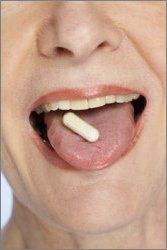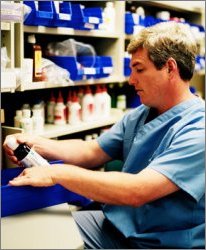Adverse Drug Reactions On the Rise: What You Can Do to Shield Yourself from the Dangers of ADRs
by www.SixWise.com
Adverse reactions to prescription drugs are occurring at
alarming rates in U.S. hospitals and elsewhere. It was known
back in 1994 that over 2.2 million hospital patients had serious
adverse drug reactions (ADRs). That same year, 106,000 patients
died from an adverse reaction to a drug.
|

Before swallowing your next pill, read the steps at
the end of this article to reduce your adverse drug
reaction risk.
|
In the Journal of the American Medical Association, which
published these results, researchers said, "The incidence
of serious and fatal adverse drug reactions in US hospitals
was found to be extremely high." That was in 1998. Today,
ADRs are still on the rise.
In 1992, there was one adverse drug reaction per every 16,300
prescriptions, according to a study by Knight-Ridder. By 2003,
the ratio had grown to one in 9,000.
Adverse Drug Reactions One of the Leading Causes of Death
The JAMA study reported that, in 1994, adverse drug reactions
were between the fourth and sixth leading cause of death in
the United States.
More recently, a study published in the New England Journal
of Medicine found that one in four patients is plagued by
side effects from prescription medications.
"It's a problem that is common, in many cases the impact
could be prevented or reduced, and it has a large impact on
patients," said Tejal Gandhi, lead author of the study
and an internist at Brigham & Women's Hospital in Boston.
Of the patients who experienced side effects (out of over
1,200 patients), 13 percent were serious (internal bleeding,
low blood pressure, etc.). Another 39 percent were preventable
or potentially treatable, such as a patient accidentally receiving
a drug he or she is allergic to.
In an editorial about the study, William Tierney of the Indiana
University School of Medicine said, "They found that
adverse drug events were fairly frequent and usually mild,
although potentially serious, and preventable events were
more frequent than any patient or clinician would like (or
should be willing) to accept."
Out of the cases that were preventable:
-
Patients were given the wrong drug 45 percent of the
time.
-
Patients were prescribed the wrong dose 10 percent of
the time.
-
Patients were told to take the drug too frequently 10
percent of the time.
If measures aren't taken to keep mistakes like these from
happening, Tierney says the outlook is dim.
" ... Given the increasing number of powerful drugs
available to care for the aging population, the problem will
only get worse," he said.
Three drug classes appeared to present the greatest risk
of side effects:
-
Serotonin-reuptake inhibitor class of antidepressants
-
Non-steroidal anti-inflammatory drugs (NSAIDs), often
used for joint pain
-
Calcium-channel blockers, used to treat high blood pressure
Other studies have also found that adverse drug reactions
represent a serious risk to Americans. Findings include:
-
An estimated 5 percent of hospital admissions -- over
1 million per year -- are due to drug side effects.
-
ADRs were directly responsible for the hospital admission
3.8 percent of the time, yet 57 percent of them were not
recognized by the physician at the time of admission.
-
18.6 percent of all drugs prescribed prior to hospital
admission were contraindicated.
-
Up to 88 percent of ADR-related hospitalizations in the
elderly are preventable.
-
Nursing home residents suffer 350,000 ADRs a year, according
to the Institute of Medicine.
|

Doctors are only human -- they do NOT have all potential
drug interactions memorized. After asking your doctor
about possible adverse drug reactions for a prescribed
medication, double-check by asking your pharmacist.
|
Billions of Prescriptions, Reactions Not Reported
Over 3.3 billion prescriptions were given out in the United
States in 2002. With all of these drugs being taken, it seems
an obvious next step would be to implement a system to track
any and all serious reactions to them.
There is such a system -- called MedWatch -- that's operated
by the Food and Drug Administration (FDA). The problem is
that reporting by doctors is voluntary, and only a small percentage
of incidents are actually represented in the database, according
to the FDA.
Meanwhile, many ADRs are never recognized for what they are,
and the patient may instead be diagnosed with a new "disease."
According to Gandhi's study, in close to two-thirds of the
cases side effects continued because doctors did not notice
warning signs. In the remaining cases, symptoms persisted
because the patients did not mention them to their doctors.
"A lot of problems were going on a long time that weren't
being fixed, either because the patients didn't tell the doctor
or the physicians didn't change the medication. That was what
surprised us ... With these 10-minute appointments, it's
hard for the doctor to get into whether the symptoms are bothering
the patients," Gandhi said.
Steps to Reduce Your Adverse Drug Reaction Risk
Ideally, the best way to reduce your risk of having an adverse
reaction to a drug is to limit your exposure to them in the
first place. This is something that can (and should) be done
as a matter of course throughout your life by:
Sometimes, though, drugs are necessary and unavoidable. For
these times, it is up to you to be an informed patient and
proactively work with your doctor to help reduce your risk
of ADR.
Doctors are human and do not always check for potential drug
interactions, correct dosages or allergies -- so don't assume
that this has been done. The next time you receive a prescription,
take these steps to reduce your risk of ADR:
i. Be aware that you are at an increased risk of ADR
if you are taking two or more medications (and an extremely
increased risk if taking four or more).
ii. Make sure your doctor is aware of your medication
history and drugs you are currently taking -- including
vitamins, herbs and over-the-counter meds. If he or she
doesn't ask (though they should), bring it up and tell them
yourself!
iii. If you are taking multiple drugs, ask your doctor
specifically: "Will this new medication interact with
X, Y or Z?" (the medications you're already taking)
iv. Be aware that certain drug categories are especially
risky in terms of interactions. These include:
a. Anticonvulsants
b. Antibiotics
c. Certain cardiac drugs such as digoxin, warfarin,
and amiodarone
v. When picking up the prescription, check again with
the pharmacist by asking if this drug interacts with any
drug you are already taking, possible side effects, risks,
etc.
vi. If you experience any unusual symptoms upon taking
the medication, call your doctor immediately and explain
the problem.
Recommended Reading
The
Danger of Antacids and What You Should Do Instead
Do
You Really Need a Multivitamin Supplement?
Sources
The
Shreveport Times April 1, 2006
ContraCosta
Times March 27, 2006
JAMA.
1998 Apr 15;279(15):1200-5
Medication
Side Effects Strike 1 in 4
WorstPills.org
Center
for Drug Evaluation and Research